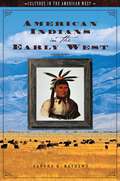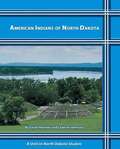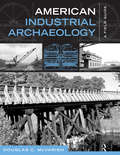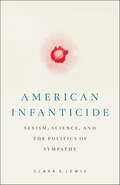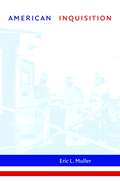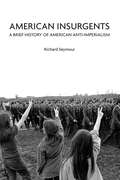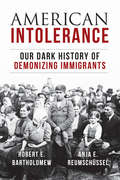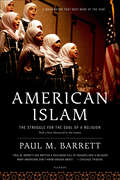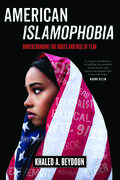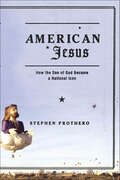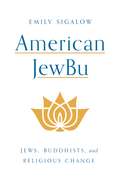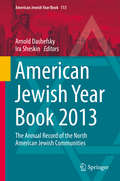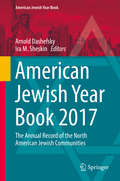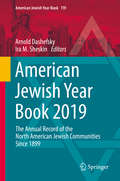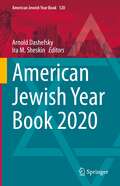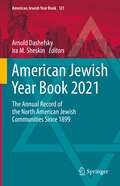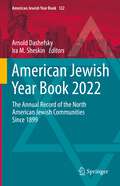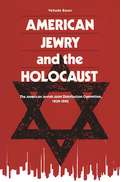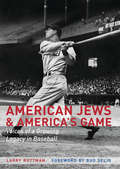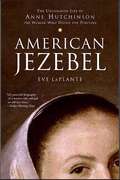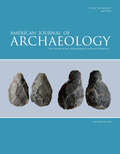- Table View
- List View
American Indians in the Early West (Cultures in the American West)
by Sandra K. MathewsMathews (history, U. of New Mexico) offers an alternative view to histories that concentrate on the violent and often tragic confrontations between native Americans and Anglo-Americans in the 19th century. Instead, she concentrates on the clashes between the Indian nations and colonizers that began almost 300 years before the United States was born. Topics include the origins, migrations and geographical location of the earlier native Americans, the history of the Spanish in the southwest, the history of the French from the Saint Lawrence and Great Lakes to the Rocky Mountains and Russian involvement from the Aleutian Chain to Northern California. The book also addresses major issues in the study of American Indian history. Annotation ©2008 Book News, Inc., Portland, OR (booknews.com)
American Indians of North Dakota (North Dakota Studies)
by Gwyn S. Herman Laverne A. JohnsonThis book is filled with interesting history, impressive facts, and inspiring profiles. Through reading and engaging in the variety of activities that accompany this text, you will find yourself on a dynamic and educational journey of discovery.
American Indians of the Pikes Peak Region
by Pikes Peak Historical Society Celinda R. KaelinThousands of years before Zebulon Pike's name became attached to this famous mountain, Pikes Peak was home to indigenous people. These First Nations left no written record of their sojourn here, but what they did leave were stone circles, carefully crafted arrowheads and stone tools, enigmatic petroglyphs, and culturally scarred trees. In the 1500s, Spanish explorers documented their locations, language, and numbers. In the 1800s, mountain men and official explorers such as Pike, Fremont, and Long also wrote about these First Nations. Comanche, Apache, Arapaho, Cheyenne, Kiowa, and Lakota made incursions into the region. These nations contested Ute land possession, harvested the abundant wildlife, and paid homage to the powerful spirits at Garden of the Gods and Manitou Springs. Today Ute Indians return to Garden of the Gods and to Pikes Peak each year to perform their sacred Sundance Ceremony.
American Indians: Stereotypes and Realities
by Devon A. MihesuahAmerican Indians are portrayed in many ways, but often the portraits reflect more myth than reality. "This book is not intended to chronicle the history of any tribe or to analyze its culture, nor to detail intricacies of American Indian tribal politics, law, or economics. It is not intended to glorify Indians nor to criticize those people who believe the myths. Its purpose is to stimulate dialogue and to correct some of the most prevalent misconceptions about Indians. There are more, no doubt. But it is my hope that this bookwill spur teachers to fight for better textbooks-books that include a complete history of this country -and to push for multicultural curriculums. It is important for all of us to recognize and to combat stereotypes. All peoples deserve to have their histories and cultures properly placed in the scheme of things. Anything less does us all a disservice." Mihesuah includes a generous number of recommended readings.
American Industrial Archaeology: A Field Guide
by Douglas C McVarishThis comprehensive guide provides the reader with basic information of the most common types of structures, sites, and objects encountered in industrial archaeology. These include bridges, railroads, roads, waterways, several types of production and extraction factories, water and power generating facilities, and others. Each chapters contains a brief introduction to the technology or features of each class of installation, illustrations with characteristics that help identifying important elements of the type, and a glossary of common terms. Two chapters offer valuable guidance on researching industrial properties and landscapes. For students, avocational archaeologists, and cultural resource management surveys, this volume will be an essential reference.
American Infanticide: Sexism, Science, and the Politics of Sympathy (Critical Issues in Crime and Society)
by Clara S. LewisOn April 22, 2015, the sorority sisters at Ohio’s Muskingum University’s Delta house encountered a horrific scene: pools of blood and gore in the first-floor bathroom. No one knew exactly what had happened, but the sisters suspected it had something to do with Emile Weaver. Studious, athletic, and well-liked, Emile had recently started wearing bulky sweatsuits and hiding her midsection, as if she was covering up a sudden weight gain. Could Emile be pregnant? Emboldened by fear, the sorority sisters investigated. In the driveway next to the kitchen door, they found Emile’s newborn baby girl dead inside a garbage bag. Emile’s crime seemed senseless and left her family and friends with an aching question: what happened? American Infanticide situates Emile's tragic act in a long intellectual, social, and legal history, uncovering disturbing missing chapters in our national history that undercut myths that have shaped public reactions to so-called monster moms and dumpster babies since the colonial era. Ultimately, the book uncovers how bias and inconsistency dictate how women accused of infant homicide are perceived and punished and sheds new light on how and why our legal responses to infanticide are so deeply misguided.
American Inquisition
by Eric L. MullerWhen the U.S. government forced 70,000 American citizens of Japanese ancestry into internment camps in 1942, it created administrative tribunals to pass judgment on who was loyal and who was disloyal. In American Inquisition, Eric Muller relates the untold story of exactly how military and civilian bureaucrats judged these tens of thousands of American citizens during wartime. Some citizens were deemed loyal and were freed, but one in four was declared disloyal to America and condemned to repressive segregation in the camps or barred from war-related jobs. Using cultural and religious affiliations as indicators of Americans' loyalties, the far-reaching bureaucratic decisions often reflected the agendas of the agencies that performed them rather than the actual allegiances or threats posed by the citizens being judged, Muller explains.American Inquisition is the only study of the Japanese American internment to examine the complex inner workings of the most draconian system of loyalty screening that the American government has ever deployed against its own citizens. At a time when our nation again finds itself beset by worries about an "enemy within" considered identifiable by race or religion, this volume offers crucial lessons from a recent and disastrous history.
American Insurgents
by Richard Seymour"Seymour's obsessively researched, impressive first book holds its place as the most authoritative historical analysis of its kind."--Resurgence All empires spin self-serving myths, and in the United States the most potent of these is that America is a force for democracy around the world. Yet there is a tradition of American anti-imperialism which gives the lie to this mythology. Richard Seymour examines this complex relationship from the Revolution to the present-day. Richard Seymour is a socialist writer and runs the blog Lenin's Tomb. He is the author of The Liberal Defense of Murder. His articles have appeared in the Guardian and New Statesman.
American Intolerance: Our Dark History of Demonizing Immigrants
by Robert E. Bartholomew Anja ReumschuesselThis historical review of the US treatment of immigrants and minority groups documents the suspicion and persecution that often met newcomers and those perceived to be different.Contrary to popular belief, the poor and huddled masses were never welcome in America. Though the engraving on the base of the Statue of Liberty makes that claim, history reveals a far less-welcoming message. This comprehensive survey of cultural and racial exclusion in the United States examines the legacy of hostility toward immigrants over two centuries. The authors document abuses against Catholics in the early 19th century in response to the influx of German and Irish immigrants; hostility against Mexicans throughout the Southwest, where signs in bars and restaurants read, "No Dogs, No Negros, No Mexicans"; "yellow peril" fears leading to a ban on Chinese immigration for ten years; punitive measures against Native Americans traditions, which became punishable by fines and hard labor; the persecution of German Americans during World War I and Japanese Americans during World War II; the refusal to admit Jewish refugees of the Holocaust; and the ongoing legacy of mistreating African Americans from slavery to the injustices of the present day.Though the authors note that the United States has accepted tens of millions of immigrants during its relatively short existence, its troubling history of persecution is often overlooked. President Donald Trump's targeting of Muslim and Mexican immigrants is just the most recent chapter in a long, sad history of social panics about "evil" foreigners who are made scapegoats due to their ethnicity or religious beliefs.
American Islam: The Struggle for the Soul of a Religion
by Paul M. BarrettVivid, dramatic portraits of Muslims in America in the years after 9/11, as they define themselves in a religious subculture torn between moderation and extremismThere are as many as six million Muslims in the United States today. Islam (together with Christianity and Judaism) is now an American faith, and the challenges Muslims face as they reconcile their intense and demanding faith with our chaotic and permissive society are recognizable to all of us.From West Virginia to northern Idaho, American Islam takes readers into Muslim homes, mosques, and private gatherings to introduce a population of striking variety. The central characters range from a charismatic black imam schooled in the militancy of the Nation of Islam to the daughter of an Indian immigrant family whose feminist views divided her father's mosque in West Virginia. Here are lives in conflict, reflecting in different ways the turmoil affecting the religion worldwide. An intricate mixture of ideologies and cultures, American Muslims include immigrants and native born, black and white converts, those who are well integrated into the larger society and those who are alienated and extreme in their political views. Even as many American Muslims succeed in material terms and enrich our society, Islam is enmeshed in controversy in the United States, as thousands of American Muslims have been investigated and interrogated in the wake of 9/11.American Islam is an intimate and vivid group portrait of American Muslims in a time of turmoil and promise.
American Islamophobia: Understanding The Roots And Rise Of Fear
by Khaled A. Beydoun“I remember the four words that repeatedly scrolled across my mind after the first plane crashed into the World Trade Center in New York City. ‘Please don’t be Muslims, please don’t be Muslims.’ The four words I whispered to myself on 9/11 reverberated through the mind of every Muslim American that day and every day after.… Our fear, and the collective breath or brace for the hateful backlash that ensued, symbolize the existential tightrope that defines Muslim American identity today.” The term “Islamophobia” may be fairly new, but irrational fear and hatred of Islam and Muslims is anything but. Though many speak of Islamophobia’s roots in racism, have we considered how anti-Muslim rhetoric is rooted in our legal system? Using his unique lens as a critical race theorist and law professor, Khaled A. Beydoun captures the many ways in which law, policy, and official state rhetoric have fueled the frightening resurgence of Islamophobia in the United States. Beydoun charts its long and terrible history, from the plight of enslaved African Muslims in the antebellum South and the laws prohibiting Muslim immigrants from becoming citizens to the ways the war on terror assigns blame for any terrorist act to Islam and the myriad trials Muslim Americans face in the Trump era. He passionately argues that by failing to frame Islamophobia as a system of bigotry endorsed and emboldened by law and carried out by government actors, U.S. society ignores the injury it inflicts on both Muslims and non-Muslims. Through the stories of Muslim Americans who have experienced Islamophobia across various racial, ethnic, and socioeconomic lines, Beydoun shares how U.S. laws shatter lives, whether directly or inadvertently. And with an eye toward benefiting society as a whole, he recommends ways for Muslim Americans and their allies to build coalitions with other groups. Like no book before it, American Islamophobia offers a robust and genuine portrait of Muslim America then and now.
American Jesus: How the Son of God Became a National Icon
by Stephen ProtheroA Deep Dive into America's Complex Relationship with JesusThere's no denying America's rich religious background–belief is woven into daily life. But as Stephen Prothero argues in American Jesus, many of the most interesting appraisals of Jesus have emerged outside the churches: in music, film, and popular culture; and among Jews, Muslims, Buddhists, and people of no religion at all.Delve into this compelling chronicle as it explores how Jesus, the carpenter from Nazareth, has been refashioned into distinctly American identities over the centuries. From his enlistment as a beacon of hope for abolitionists to his appropriation as a figurehead for Klansmen, the image of Jesus has been as mercurial as it is influential. In this diverse and conflicted scene, American Jesus stands as a testament to the peculiar fusion of the temporal and divine in contemporary America.Equal parts enlightening and entertaining, American Jesus goes beyond being simply a work of history. It’s an intricate mirror, reflecting the American spirit while questioning the nation's socio-cultural fabric.
American JewBu: Jews, Buddhists, and Religious Change
by Emily SigalowA revealing look at the Jewish American encounter with BuddhismToday, many Jewish Americans are embracing a dual religious identity, practicing Buddhism while also staying connected to their Jewish roots. This book tells the story of Judaism's encounter with Buddhism in the United States, showing how it has given rise to new contemplative forms within American Judaism—and shaped the way Americans understand and practice Buddhism.Taking readers from the nineteenth century to today, Emily Sigalow traces the history of these two traditions in America and explains how they came together. She argues that the distinctive social position of American Jews led them to their unique engagement with Buddhism, and describes how people incorporate aspects of both into their everyday lives. Drawing on a wealth of original in-depth interviews conducted across the nation, Sigalow explores how Jewish American Buddhists experience their dual religious identities. She reveals how Jewish Buddhists confound prevailing expectations of minority religions in America. Rather than simply adapting to the majority religion, Jews and Buddhists have borrowed and integrated elements from each other, and in doing so they have left an enduring mark on the American consciousness.American JewBu highlights the leading role that American Jews have played in the popularization of meditation and mindfulness in the United States, and the profound impact that these two venerable traditions have had on one another.
American Jewish Filmmakers
by Lester D. Friedman David DesserWoody Allen, Mel Brooks, Sidney Lumet, and Paul Mazursky, all sons of East European Jews, remain among the most prominent contemporary American film directors. In this revised, updated second edition of American Jewish Filmmakers, David Desser and Lester D. Friedman demonstrate how the Jewish experience gives rise to an intimately linked series of issues in the films of these and other significant Jewish directors. The effects of the Holocaust linger, both in gripping dramatic form (Mazursky's Enemies, a Love Story) and in black comedy (Brooks's The Producers). In his trilogy consisting of Serpico, Prince of the City, and Q&A, Lumet focuses on the failure of society's institutions to deliver social justice. Woody Allen portrays urban life and family relationships (Manhattan and Hannah and Her Sisters), sometimes with a nostalgic twist (Radio Days). This edition concludes with a newly written discussion of the careers of other prominent Jewish filmmakers such as Steven Spielberg, Barry Levinson, Brian Singer, and Darren Aronofsky.
American Jewish Year Book 2012: The Annual Record of the North American Jewish Communities (American Jewish Year Book #113)
by Ira Sheskin Arnold DashefskyThe 2012 American Jewish Year Book, "The Annual Record of American Jewish Civilization," contains major chapters on Jewish secularism (Barry Kosmin and Ariela Keysar), Canadian Jewry (Morton Weinfeld, David Koffman, and Randal Schnoor), national affairs (Ethan Felson), Jewish communal affairs (Lawrence Grossman), Jewish population in the United States (Ira Sheskin and Arnold Dashefsky), and World Jewish population (Sergio DellaPergola). These chapters provide insight into major trends in the North American and world Jewish community. The volume also acts as a resource for the American Jewish community and for academics studying that community by supplying obituaries and lists of Jewish Federations, Jewish Community Centers, national Jewish organizations, Jewish overnight camps, Jewish museums, Holocaust museums, local and national Jewish periodicals, Jewish honorees, major recent events in the American Jewish community, and academic journals, articles, websites, and books. The volume should prove useful to social scientists and historians of the American Jewish community, Jewish communal workers, the press, and others interested in American and Canadian Jews.
American Jewish Year Book 2017: The Annual Record of the North American Jewish Communities (American Jewish Year Book #117)
by Arnold Dashefsky Ira M. SheskinThe American Jewish Year Book, now in its 117th year, is the annual record of the North American Jewish communities and provides insight into their major trends. The first chapter of Part I is an examination of how American Jews fit into the US religious landscape, based on Pew Research Center studies. The second chapter examines intermarriage. Chapters on "The Domestic Arena" and "The International Arena" analyze the year's events as they affect American Jewish communal and political affairs. Three chapters analyze the demography and geography of the US, Canada, and world Jewish populations. Part II provides lists of Jewish institutions, including federations, community centers, social service agencies, national organizations, synagogues, Hillels, day schools, camps, museums, and Israeli consulates. The final chapters present national and local Jewish periodicals and broadcast media; academic resources, including Jewish Studies programs, books, journals, articles, websites, and research libraries; and lists of major events in the past year, Jewish honorees, and obituaries.
American Jewish Year Book 2019: The Annual Record of the North American Jewish Communities Since 1899 (American Jewish Year Book #119)
by Arnold Dashefsky Ira M. SheskinPart I of each volume will feature 5-7 major review chapters, including 2-3 long chapters reviewing topics of major concern to the American Jewish community written by top experts on each topic, review chapters on "National Affairs" and "Jewish Communal Affairs" and articles on the Jewish population of the United States and the World Jewish Population. Future major review chapters will include such topics as Jewish Education in America, American Jewish Philanthropy, Israel/Diaspora Relations, American Jewish Demography, American Jewish History, LGBT Issues in American Jewry, American Jews and National Elections, Orthodox Judaism in the US, Conservative Judaism in the US, Reform Judaism in the US, Jewish Involvement in the Labor Movement, Perspectives in American Jewish Sociology, Recent Trends in American Judaism, Impact of Feminism on American Jewish Life, American Jewish Museums, Anti-Semitism in America, and Inter-Religious Dialogue in America. Part II-V of each volume will continue the tradition of listing Jewish Federations, national Jewish organizations, Jewish periodicals, and obituaries. But to this list are added lists of Jewish Community Centers, Jewish Camps, Jewish Museums, Holocaust Museums, and Jewish honorees (both those honored through awards by Jewish organizations and by receiving honors, such as Presidential Medals of Freedom and Academy Awards, from the secular world). We expand the Year Book tradition of bringing academic research to the Jewish communal world by adding lists of academic journals, articles in academic journals on Jewish topics, Jewish websites, and books on American and Canadian Jews. Finally, we add a list of major events in the North American Jewish Community.
American Jewish Year Book 2020: The Annual Record of the North American Jewish Communities Since 1899 (American Jewish Year Book #120)
by Arnold Dashefsky Ira M. SheskinThe American Jewish Year Book, which spans three different centuries, is the annual record of the North American Jewish communities and provides insight into their major trends. Part I of the current volume contains the lead article: Chapter 1, “Pastrami, Verklempt, and Tshoot-spa: Non-Jews’ Use of Jewish Language in the US” by Sarah Bunin Benor. Following this chapter are three on domestic and international events, which analyze the year’s events as they affect American Jewish communal and political affairs. Three chapters analyze the demography and geography of the US, Canada, and world Jewish populations. Part II provides lists of Jewish institutions, including federations, community centers, social service agencies, national organizations, synagogues, Hillels, camps, museums, and Israeli consulates. The final chapters present national and local Jewish periodicals and broadcast media; academic resources, including Jewish Studies programs, books, journals, articles, websites, and research libraries; and lists of major events in the past year, Jewish honorees, and obituaries. While written mostly by academics, this volume conveys an accessible style, making it of interest to public officials, professional and lay leaders in the Jewish community, as well as the general public and academic researchers. The American Jewish Year Book has been a key resource for social scientists exploring comparative and historical data on Jewish population patterns. No less important, the Year Book serves organization leaders and policy makers as the source for valuable data on Jewish communities and as a basis for planning. Serious evidence-based articles regularly appear in the Year Book that focus on analyses and reviews of critical issues facing American Jews and their communities which are indispensable for scholars and community leaders.Calvin Goldscheider, Professor Emeritus of Sociology and Ungerleider Professor Emeritus of Judaic Studies, Brown University They have done it again. The American Jewish Year Book has produced yet another edition to add to its distinguished tradition of providing facts, figures and analyses of contemporary life in North America. Its well-researched and easily accessible essays offer the most up to date scrutiny of topics and challenges of importance to American Jewish life; to the American scene of which it is a part and to world Jewry. Whether one is an academic or professional member of the Jewish community (or just an interested reader of all things Jewish), there is not another more impressive and informative reading than the American Jewish Year Book. Debra Renee Kaufman, Professor Emerita and Matthews Distinguished University Professor, Northeastern University
American Jewish Year Book 2021: The Annual Record of the North American Jewish Communities Since 1899 (American Jewish Year Book #121)
by Arnold Dashefsky Ira M. SheskinAcross three centuries, AJYB has provided insight into major trends. Part I of the current volume contains two chapters on Jewish Americans in 2020 by the Pew Research Center, including reactions from 16 prominent social scientists. Subsequent chapters analyze the development of Holocaust consciousness in America, recent domestic and international events as they affect the American Jewish community, and the demography and geography of the US, Canada, and world Jewish populations. Part II provides lists of Jewish institutions, including federations, community centers, social service agencies, national organizations, camps, museums, and Israeli consulates. The final chapters present lists of Jewish periodicals and broadcast media, Jewish Studies programs, books, journals, articles, websites, research libraries, and academic conferences and lists of major events in the past year, Jewish honorees, and obituaries. This volume employs an accessible style, making it of interest to public officials, Jewish professional and lay leaders, as well as the general public and academic researchers.For more than 120 years the American Jewish Year Book has served as an indispensable resource for scholars, clergy, and lay leaders, providing crucial, detailed insights into demographic shifts and sociological trends in the North American Jewish community. The latest edition continues to fulfill these important needs with essential articles on the landmark Pew Report and the impact of the Holocaust in the American Jewish community and American in general. This is a must-have volume for any serious student of the contemporary Jewish world.Jeffrey Shoulson, Senior Vice Provost for Academic Affairs, Professor of Literatures, Cultures, and Languages, and English, Director Emeritus Center for Judaic Studies and Contemporary Jewish Life, University of ConnecticutThe American Jewish Year Book is a critical snapshot of Jews and Jewish Studies in the United States in a particular year, and a valuable resource for scholars studying the changes in Jewish communities and Jewish Studies in the United States (and beyond!) over time. The AJYB highlights major publications and data that are consistently used in research, and its scholarly essays contextualize the information in an easily readable context. The lists of important institutions and organizations are invaluable for someone interested in the broader Jewish experience (or, at the most practical, a Jewish organization in their neighborhood!).Michelle Margolis Chesner, Norman E. Alexander Librarian for Jewish Studies, Columbia University
American Jewish Year Book 2022: The Annual Record of the North American Jewish Communities Since 1899 (American Jewish Year Book #122)
by Arnold Dashefsky Ira M. SheskinAcross three different centuries, the American Jewish Year Book has provided insight into major trends among Jews primarily in North America. Part I of the current volume contains two chapters: One is a critical assessment of the major American Jewish Population Surveys over the past fifty years (1970-2020). The second chapter is an assessment of the media coverage of Israel in the American Press. Subsequent chapters address recent domestic and international events as they affect the American Jewish community, and the demography and geography of the US, Canada, and World Jewish populations. Part II provides lists of Jewish institutions, including federations, community centers, social service agencies, national organizations, camps, museums, and Israeli consulates. The final chapters present lists of Jewish periodicals and broadcast media, Jewish Studies programs, books, journals, articles, websites, research libraries, and academic conferences as well as lists of major events in the past year, Jewish honorees, and obituaries. This volume employs an accessible style, making it of interest to public officials, Jewish professional and lay leaders, as well as the general public and academic researchers.The American Jewish Year Book is a tremendously useful resource for scholars, Jewish community professionals, pundits, clergy, and policy makers. For over a century, it has offered comprehensive insight into North American Jewish demography, sociology, and culture. It remains a vital source for comprehending the complexities of American and Canadian Jewish life.Robin Judd, Associate Professor of History and Director of the Hoffman Program for Leaders and Leadership in History, The Ohio State UniversityThe American Jewish Year Book is the first draft of history, documenting the trends and topics of interest for such an organized community. Looking through the 100+ volumes, we can track how discussions have changed over time, which concerns have returned, and how we arrived at the current point in time. It is a valuable tool for anyone interested in trends in American Jewish life.David Manchester, Director of the Berman Jewish DataBank and Director of Community Data and Research Development at The Jewish Federations of North America
American Jewry and the Holocaust: The American Jewish Joint Distribution Committee, 1939-1945
by Yehuda BauerIn this volume Yehudi Bauer describes the efforts made to aid European victims of World War II by the New York-based American Jewish Joint Distribution Committee, American Jewry's chief representative abroad. Drawing on the mass of unpublished material in the JDC archives and other repositories, as well as on his thorough knowledge of recent and continuing research into the Holocaust, he focuses alternately on the personalities and institutional decisions in New York and their effects on the JDC workers and their rescue efforts in Europe. He balances personal stories with a country-by-country account of the fate of Jews through ought the war years: the grim statistics of millions deported and killed are set in the context of the hopes and frustrations of the heroic individuals and small groups who actively worked to prevent the Nazis' Final Solution. This study is essential reading for anyone who seeks to understand the American Jewish response to European events from 1939 to 1945. Bauer confronts the tremendous moral and historical questions arising from JDC's activities. How great was the danger? Who should be saved first? Was it justified to use illegal or extralegal means? What country would accept Jewish refugees? His analysis also raises an issue which perhaps can never be answered: could American Jews have done more if they had grasped the reality of the Holocaust?
American Jews and America's Game: Voices of a Growing Legacy in Baseball
by Larry Ruttman Dr Martin Abramowitz Allan H SeligMost fans don’t know how far the Jewish presence in baseball extends beyond a few famous players such as Greenberg, Rosen, Koufax, Holtzman, Green, Ausmus, Youkilis, Braun, and Kinsler. In fact, that presence extends to the baseball commissioner Bud Selig, labor leaders Marvin Miller and Don Fehr, owners Jerry Reinsdorf and Stuart Sternberg, officials Theo Epstein and Mark Shapiro, sportswriters Murray Chass, Ross Newhan, Ira Berkow, and Roger Kahn, and even famous Jewish baseball fans like Alan Dershowitz and Barney Frank. The life stories of these and many others, on and off the field, have been compiled from nearly fifty in-depth interviews and arranged by decade in this edifying and entertaining work of oral and cultural history. In American Jews and America’s Game each person talks about growing up Jewish and dealing with Jewish identity, assimilation, intermarriage, future viability, religious observance, anti-Semitism, and Israel. Each tells about being in the midst of the colorful pantheon of players who, over the past seventy-five years or more, have made baseball what it is. Their stories tell, as no previous book has, the history of the larger-than-life role of Jews in America’s pastime.
American Jezebel: The Uncommon Life of Anne Hutchinson, the Woman Who Defied the Puritans
by Eve LaPlanteIn 1637, Anne Hutchinson, a forty-six-year-old midwife who was pregnant with her sixteenth child, stood before forty male judges of the Massachusetts General Court, charged with heresy and sedition. In a time when women could not vote, hold public office, or teach outside the home, the charismatic Hutchinson wielded remarkable political power. Her unconventional ideas had attracted a following of prominent citizens eager for social reform. Hutchinson defended herself brilliantly, but the judges, faced with a perceived threat to public order, banished her for behaving in a manner "not comely for [her] sex."Written by one of Hutchinson's direct descendants, American Jezebel brings both balance and perspective to Hutchinson's story. It captures this American heroine's life in all its complexity, presenting her not as a religious fanatic, a cardboard feminist, or a raging crank—as some have portrayed her—but as a flesh-and-blood wife, mother, theologian, and political leader. The book narrates her dramatic expulsion from Massachusetts, after which her judges, still threatened by her challenges, promptly built Harvard College to enforce religious and social orthodoxies—making her the mid-wife to the nation's first college. In exile, she settled Rhode Island, becoming the only woman ever to co-found an American colony.The seeds of the American struggle for women's and human rights can be found in the story of this one woman's courageous life. American Jezebel illuminates the origins of our modern concepts of religious freedom, equal rights, and free speech, and showcases an extraordinary woman whose achievements are astonishing by the standards of any era.
American Journal of Archaeology, volume 126 number 1 (January 2022)
by American Journal of ArchaeologyThis is volume 126 issue 1 of American Journal of Archaeology. The American Journal of Archaeology, the journal of the Archaeological Institute of America, was founded in 1885 and is one of the world's most distinguished and widely distributed peer-reviewed archaeological journals. The AJA reaches more than 40 countries and approximately 700 universities, learned societies, departments of antiquities, and museums. The AJA publishes original research on the diverse peoples and material cultures of the Mediterranean and related areas, including North Africa (with Egypt and Sudan), Western Asia (with the Caucasus), and Europe, from prehistory through late antiquity.
American Journal of Archaeology, volume 126 number 2 (April 2022)
by American Journal of ArchaeologyThis is volume 126 issue 2 of American Journal of Archaeology. The American Journal of Archaeology, the journal of the Archaeological Institute of America, was founded in 1885 and is one of the world's most distinguished and widely distributed peer-reviewed archaeological journals. The AJA reaches more than 40 countries and approximately 700 universities, learned societies, departments of antiquities, and museums. The AJA publishes original research on the diverse peoples and material cultures of the Mediterranean and related areas, including North Africa (with Egypt and Sudan), Western Asia (with the Caucasus), and Europe, from prehistory through late antiquity.
